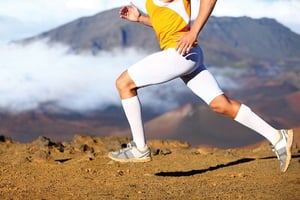by Dr. Gordon F. Gibbs
 I recently connected with Dr. Brian Babka, MD, FACSM, to discuss compression stockings’ impact on the athletes he cares for in his nonsurgical sports medicine practice at Northwestern Medicine Cadence Physician Group in Illinois. A Fellow of the American College of Sports Medicine, Dr. Babka recently spent time at the US Olympic Training Center in Colorado Springs helping athletes prepare for the 2016 Summer Olympics in Rio. He has served as team physician for the US Soccer Federation and numerous college and high school athletic teams. He also regularly serves as medical director or team physician for athletic events and games.
I recently connected with Dr. Brian Babka, MD, FACSM, to discuss compression stockings’ impact on the athletes he cares for in his nonsurgical sports medicine practice at Northwestern Medicine Cadence Physician Group in Illinois. A Fellow of the American College of Sports Medicine, Dr. Babka recently spent time at the US Olympic Training Center in Colorado Springs helping athletes prepare for the 2016 Summer Olympics in Rio. He has served as team physician for the US Soccer Federation and numerous college and high school athletic teams. He also regularly serves as medical director or team physician for athletic events and games.
Because compression therapy is such a vital part of a phlebology practice, I was curious to know the perspective of the sports medicine community on compression therapy, specifically how compression impacts this type of patient and how it might translate to the treatment of vein disease. I wanted to have the discussion in light of the fact that I see so many male patients who are weekend warriors—eternally optimistic that they could someday go to the Olympics. And in that sense, aren’t all men (myself included) forever Olympic hopefuls?
Q&A with Gordon Gibbs, MD and Brian Babka, MD

In a typical phlebology practice, graduated compression stockings are used to mitigate symptoms of venous insufficiency. Could you describe the use of compression stockings by Olympic/professional athletes?
There are three categories wherein lower extremity compression stockings can help athletes:
- Performance
- Recovery
- Travel
What do you tell athletes about how compression aids in exercise recovery?
For recovery, flushing the tissue after exercise is important to reduce symptoms of muscle fatigue and prepare the body for the next workout. Compression stockings function similarly to contrast bathing or hot/cold immersion therapy. This established practice involves athletes submersing their lower bodies in ice water, followed by a hot bath for several cycles. The variation in temperatures causes vasoconstriction followed by vasodilation on both the blood and lymphatic circulation. This creates a pump, which can positively impact the inflammation process and promote healing of damaged or sore muscles. Compression also aids this pump effect and can be done more portably and comfortably than ice/hot baths.
There is also an element of muscle soreness and fatigue that seems to be psychologically improved by compression. Compression appears to affect the brain’s perception of pain in a positive way, even though there is real micro-trauma to the muscles. So, whether the athlete is actually better or simply feels better is up for interpretation. This is an interesting topic, and I suspect more data will emerge as we gain a deeper understanding of the interplay between psychosomatic and true physiologic effects of compression.
Depending on the athlete’s situation, they benefit to varying degrees in each category. But, there is also personal preference and individual “buy-in.” In a world where a tenth of a second makes a difference, athletes are generally regular users of and are strong advocates for compression wear.
How does compression improve an athlete’s performance?
Improvements in athletic performance are thought to be the result of increased blood flow, improved venous return and improved muscle oxygenation. There is also evidence that muscle jarring and vibration are decreased by compression stockings. This, in turn, decreases stress to the muscles and soft tissue during exercise, resulting in reduced muscle fatigue. Also, by creating tension on the skin, compression stockings can also have a beneficial effect on proprioception; meaning, the brain has better feedback and the ability to know where the limb or joint is in space. This translates to improved balance and muscle contraction. The ultimate result? Improved athletic performance.
How does compression help with travel?
Most elite athletes travel regularly for competitions. Many compete internationally, which means sitting for many hours on flights around the world. I recommend full compression tights to all athletes for travel. And for any flight longer than four hours, they should walk the aisle and remember to do calf-muscle pump exercises. I not only worry about muscle recovery, but the risk of DVT (deep vein thrombosis). The last thing I want is a medical complication like a DVT to derail an athlete’s training and competition schedule. This kind of complication would actually derail any person. We are all at risk when it comes to travel-related DVTs.
What about upper body compression wear?
A vast majority of sports medicine physicians and athletes focus on using compression wear for the lower extremities, because there is more evidence that it helps in those areas. Also, athletes who use compression most frequently tend to be long-course endurance athletes (triathletes, marathoners, etc.). Compression tops are not as frequently used by them.
Today’s high-performing quarterbacks, basketball players and weightlifters do however use compression tops regularly. I believe these athletes use compression mainly for improved proprioception and performance during activity, rather than for recovery. However, weightlifters may see additional benefits for recovery and DVT prophylaxis, particularly with regards to the subclavian vein related to thoracic outlet syndrome or muscle hypertrophy.
Do you recommend compression wear to certain types of athletes over others?
Ninety percent of recreational and elite athletes who use compression are long-course endurance athletes. At the elite level, almost all use lower extremity compression to some degree. I recommend compression to all of my athletes in this category. For athletes in different categories of sport, we tailor their compression regimen to suit the sport. For swimmers, it’s mostly for recovery. For golfers, compression may be used while playing, both for recovery and for travel.
What type of compression devices do you find athletes to be most fond of?
By far, calf sleeves are the most popular among male and female athletes. They are easy to get on and off, aren’t too hot and are applicable across many types of sports. Runners love them, and soccer players can wear them under their shin guards. Calf-height socks are the next most common, followed by tights. This applies to both genders. Tights are popular among cyclists this time of year because they provide the advantage of added warmth in addition to the benefits of compression. I would guess that most men prefer not to wear thigh-highs.
Slider shorts are popular among soccer, baseball and football players (mostly men). These athletes say they wear slider shorts because of the way they make them feel, not solely for protection against turf burn.
How might compression for the professional or competitive athlete differ from what might be recommended for a patient with venous disease?
Patients with venous disease often feel noticeably better with compression stockings, mainly because of improved venous return and minimizing venous hypertension. These patients probably notice far more tangible daily results than elite athletes do. Elite athletes live in a world where they have to swim an extra million meters in order to improve their time by 0.1 seconds. This is the difference between a gold medal and not placing, and this incredible pressure may add a psychological component to the use of compression by elite athletes. In their world, anything that can possibly give them an edge is useful and desirable.
What can we expect to see from our athletes in Rio in terms of compression wear?
I suspect we will see more athletes wearing compression during events than we did in London in 2012. Typically, it will be the long-course endurance athletes (marathoners, triathletes, etc.) wearing them. Also, we’ll notice basketball players and throwers with arm sleeves and leg compression.
The greater impact will be in what we don’t see, as teams and athletes will likely place more of an emphasis on compression and recovery between events. There is so much that goes on behind the scenes that the TV cameras will never focus on. You won’t see the sleeves under the shin guards or the light compression rash guards worn on upper and lower bodies, nor will you see the slider shorts underneath.
We’re also likely to see more branding of compression gear. Sports teams like to travel looking like a team, so compression manufacturers will produce matching gear that may simply look like part of the uniform. Look closely and you’ll see it.
Speaking of their design, what is the point of having special seams and elastic bolstering on compression garments?
Sometimes seams in fabric are placed in a way to reduce rubbing or chafing. However, I think this has more to do with how the seams are sewn rather than their location. I believe they are generally placed to make the garment look more appealing. But, if it looks cool and it improves compliance, then that is a positive thing.
As far as fabric bolstering to improve the performance of the garment goes, I don’t know of any data that says it works. That said, there is also little to no data to say that it is harmful. Since the difference between a gold medal and 4th place can involve very subtle differences in performance, we take every advantage we can, even if it’s by way of placebo effect or athlete perception. For the recreational athlete or vein patient, there is likely no advantage to seam positioning or fabric bolstering other than the potential for improved compliance or durability.
What advice do you have on compression stockings for practitioners who specialize in venous disease?
In many ways, the traditional graduated compression stocking market has morphed to be much more consumer friendly. This is the result of athletic compression stockings that feature better designs, fabrics and colors. They’re also far more accessible. Someone can buy a pair of compression stockings from Amazon or their local running store and see benefits without a prescription or hefty price tag. However, while athletic stockings may now be more user-friendly, they also tend to be less regulated, so you can’t tell exactly how compressive they are. They aren’t being custom-fitted, nor is their use being followed up by a health care provider.
This is analogous to the nutritional supplement market. Even if we as clinicians don’t necessarily advocate for a particular nutritional supplement or homeopathy, patients will ask us about them, and we should, at a minimum, have an awareness and understanding of their impact on care. The same is true for the variety of compression styles and brands available. A better market awareness will improve your ability to advise your patients appropriately, so my main piece of advice is to educate yourself.


